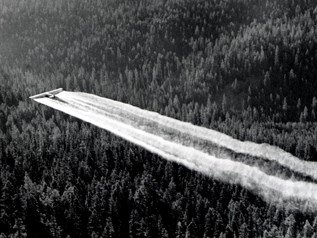When the Pest Management Regulatory Agency (PMRA) released its proposed decision to phase out the outdoor use of clothianidin and thiamethoxam, two products used by canola growers to prevent damage caused by flea beetles, it caused more than a ripple of concern in the farm sector.
Of course, it is not the first time a much-used chemical has later been banned, dichloro-diphenyl-trichloroethane (commonly known as DDT) being perhaps the most obvious one.
DDT was discovered as an agent prior to 1900 and it was made available for public use in the United States in 1945. It was, over time, found to have an environmental impact on birds such as the bald eagle and it was eventually banned in the U.S. around 1973 when the courts made a final ruling on its ban.
Some might draw a rather straight parallel between DDT and neonics in the sense both are chemicals that research has suggested impacts species other than those its application seeks to control.
There have been a number of reports where neonics are being blamed, at least in part, for the sudden decline in some bee populations.
The canola sector is a key stakeholder in this debate as the chemicals are used for flea beetle control in the crop.
To their credit they want science to be at the heart of whatever decision is made.
“The canola industry continues to support PMRA’s science-based decision-making process. The canola industry relies on continued investment in agricultural innovation, which is facilitated by predictable and science-based regulatory approval processes,” noted a release at www.canolacouncil.org.
But therein lies the heart of the concern as well.
There have been bans made in Europe, but the U.S. does not seem headed down that path. It would seem reasonable that all regulatory bodies have access to the same pure science, which means interpretation, or the comfort level with the potential risk, is what drives decisions.
“Grain farmers are concerned that the Pest Management Regulatory Agency’s re-evaluation process is focused on publishing proposed decisions as fast as possible. It appears that this speed limits their ability to ensure all relevant information is available and prevents them from engaging farmers so that we can fully understand the issues they raise, which would allow us to provide the PMRA with the information required to refine these decisions. GGC will be reviewing today’s decision on Clothianidin and Thiamethoxam and will provide further comment once that review is complete,” said Jeff Nielsen, President, Grain Growers of Canada in a statement at www.ggc-pgc.ca.
“Sustainable production and science-based decisions about risk are the foundation of our industry,” said Brian Innes, vice president of public affairs for the Canola Council of Canada again at www.canolacouncil.org. “(The recent) announcement is concerning because these products are very important for our growers, and without viable alternatives, the ban will significantly impact the canola sector.”
It is the comfort zone of the risk involved here that seems key. There is risk in all things, from crossing the street to taking a shower. It’s understanding those risks and being comfortable the benefits outweigh them that is key.
It may well be neonics offer more risk than their continued use is worth.
Then the question farmers face, and regulatory bodies won’t be answering, is what pest control tools are left to farmers?
“The proposed decisions are of concern for the canola industry as a ban will reduce yield and increase the risks faced by growers. A study published in 2017 based on European growers’ experience without these products showed that growers faced an increased risk of insect damage, had lower yields and, as a result, seeded less canola. With more than 22 million acres of canola in Canada in 2018, banning these plant protection tools would have a dramatic impact,” noted the release on www.canolacouncil.org.
That would suggest limited options for control exist post ban, and that, too, presents its own risks.
Calvin Daniels is Editor with Yorkton This Week.

